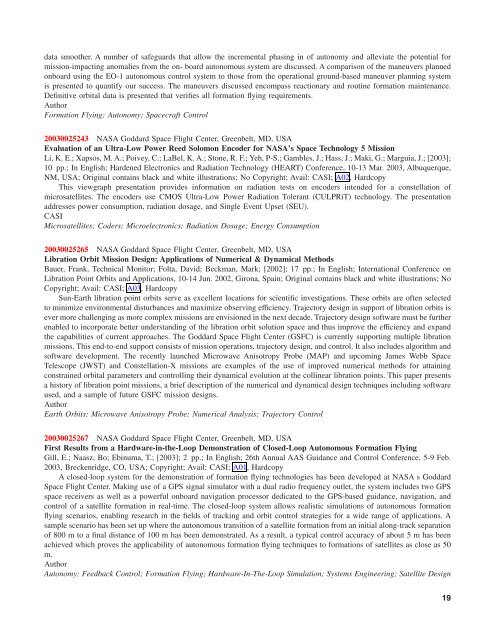Create successful ePaper yourself
Turn your PDF publications into a flip-book with our unique Google optimized e-Paper software.
data smoother. A number of safeguards that allow the incremental phasing in of autonomy and alleviate the potential for<br />
mission-impacting anomalies from the on- board autonomous system are discussed. A comparison of the maneuvers planned<br />
onboard using the EO-1 autonomous control system to those from the operational ground-based maneuver planning system<br />
is presented to quantify our success. The maneuvers discussed encompass reactionary and routine formation maintenance.<br />
Definitive orbital data is presented that verifies all formation flying requirements.<br />
Author<br />
Formation Flying; Autonomy; Spacecraft Control<br />
20030025243 NASA Goddard Space Flight Center, Greenbelt, MD, USA<br />
Evaluation of an Ultra-Low Power Reed Solomon Encoder for NASA’s Space Technology 5 Mission<br />
Li, K. E.; Xapsos, M. A.; Poivey, C.; LaBel, K. A.; Stone, R. F.; Yeh, P-S.; Gambles, J.; Hass, J.; Maki, G.; Marguia, J.; [2003];<br />
10 pp.; In English; Hardened Electronics and Radiation Technology (HEART) Conference, 10-13 Mar. 2003, Albuquerque,<br />
NM, USA; Original contains black and white illustrations; No Copyright; Avail: CASI; A02, Hardcopy<br />
This viewgraph presentation provides information on radiation tests on encoders intended for a constellation of<br />
microsatellites. The encoders use CMOS Ultra-Low Power Radiation Tolerant (CULPRiT) technology. The presentation<br />
addresses power consumption, radiation dosage, and Single Event Upset (SEU).<br />
CASI<br />
Microsatellites; Coders; Microelectronics; Radiation Dosage; Energy Consumption<br />
20030025265 NASA Goddard Space Flight Center, Greenbelt, MD, USA<br />
Libration Orbit Mission Design: Applications of Numerical & Dynamical Methods<br />
Bauer, Frank, Technical Monitor; Folta, David; Beckman, Mark; [2002]; 17 pp.; In English; International Conference on<br />
Libration Point Orbits and Applications, 10-14 Jun. 2002, Girona, Spain; Original contains black and white illustrations; No<br />
Copyright; Avail: CASI; A03, Hardcopy<br />
Sun-Earth libration point orbits serve as excellent locations for scientific investigations. These orbits are often selected<br />
to minimize environmental disturbances and maximize observing efficiency. Trajectory design in support of libration orbits is<br />
ever more challenging as more complex missions are envisioned in the next decade. Trajectory design software must be further<br />
enabled to incorporate better understanding of the libration orbit solution space and thus improve the efficiency and expand<br />
the capabilities of current approaches. The Goddard Space Flight Center (GSFC) is currently supporting multiple libration<br />
missions. This end-to-end support consists of mission operations, trajectory design, and control. It also includes algorithm and<br />
software development. The recently launched Microwave Anisotropy Probe (MAP) and upcoming James Webb Space<br />
Telescope (JWST) and Constellation-X missions are examples of the use of improved numerical methods for attaining<br />
constrained orbital parameters and controlling their dynamical evolution at the collinear libration points. This paper presents<br />
a history of libration point missions, a brief description of the numerical and dynamical design techniques including software<br />
used, and a sample of future GSFC mission designs.<br />
Author<br />
Earth Orbits; Microwave Anisotropy Probe; Numerical Analysis; Trajectory Control<br />
20030025267 NASA Goddard Space Flight Center, Greenbelt, MD, USA<br />
First Results from a Hardware-in-the-Loop Demonstration of Closed-Loop Autonomous Formation Flying<br />
Gill, E.; Naasz, Bo; Ebinuma, T.; [2003]; 2 pp.; In English; 26th Annual AAS Guidance and Control Conference, 5-9 Feb.<br />
2003, Breckenridge, CO, USA; Copyright; Avail: CASI; A01, Hardcopy<br />
A closed-loop system for the demonstration of formation flying technologies has been developed at NASA s Goddard<br />
Space Flight Center. Making use of a GPS signal simulator with a dual radio frequency outlet, the system includes two GPS<br />
space receivers as well as a powerful onboard navigation processor dedicated to the GPS-based guidance, navigation, and<br />
control of a satellite formation in real-time. The closed-loop system allows realistic simulations of autonomous formation<br />
flying scenarios, enabling research in the fields of tracking and orbit control strategies for a wide range of applications. A<br />
sample scenario has been set up where the autonomous transition of a satellite formation from an initial along-track separation<br />
of 800 m to a final distance of 100 m has been demonstrated. As a result, a typical control accuracy of about 5 m has been<br />
achieved which proves the applicability of autonomous formation flying techniques to formations of satellites as close as 50<br />
m.<br />
Author<br />
Autonomy; Feedback Control; Formation Flying; Hardware-In-The-Loop Simulation; Systems Engineering; Satellite Design<br />
19
















